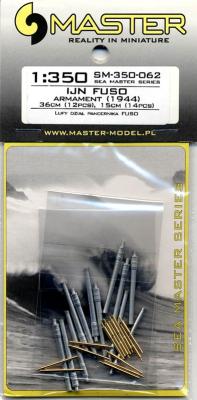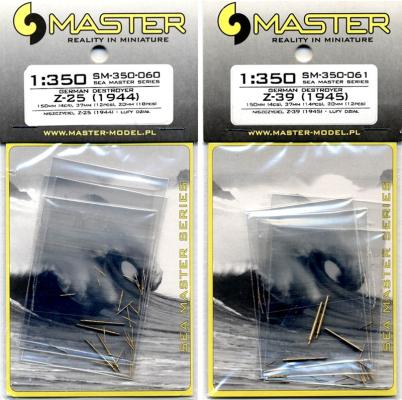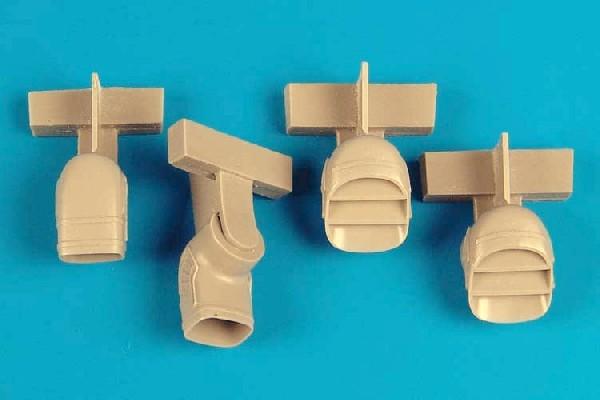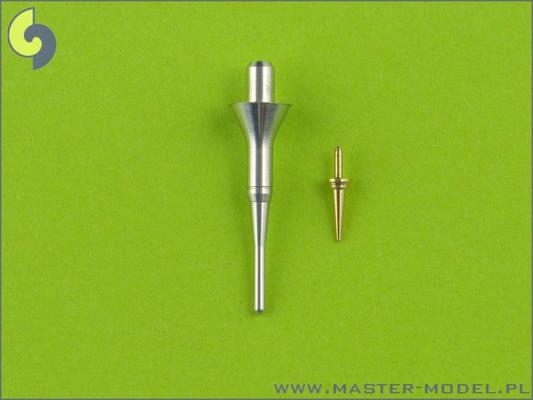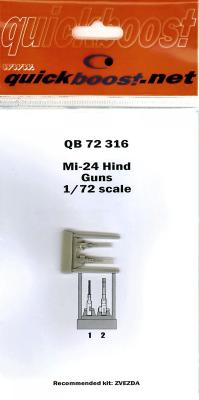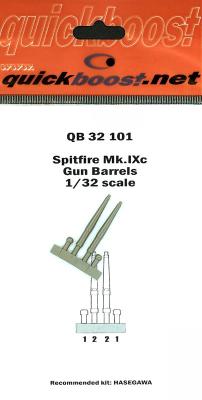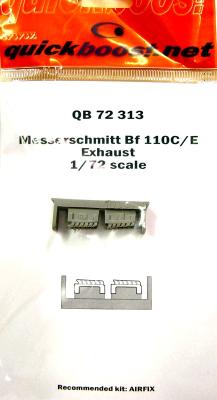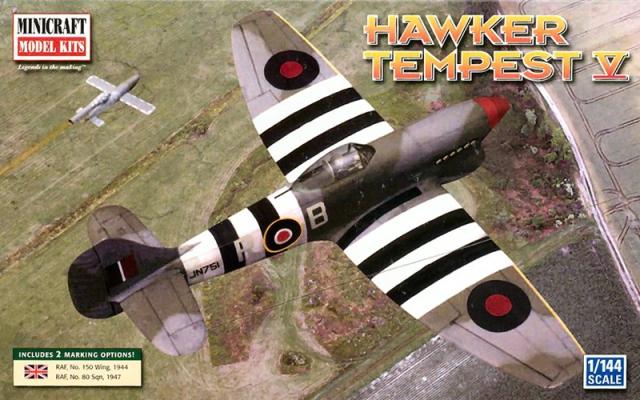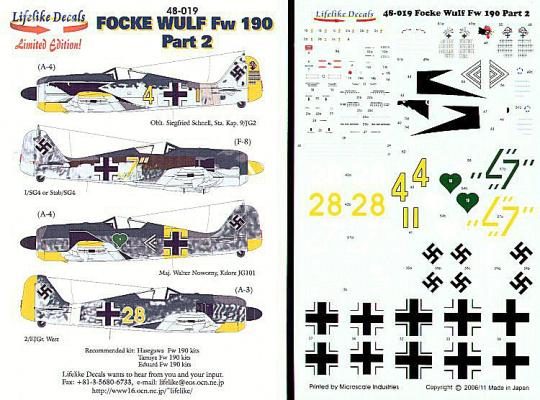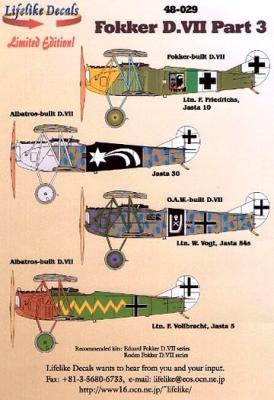Master from Poland has added to their impressive line of Sea Master Series detailed ship gun barrels with this set of main and secondary guns for the Fujimi battleship Fuso. Included in this set are twelve 14” (360 mm) turned stainless steel barrels, and fourteen 6” (150mm) turned brass barrels. Both the brass and steel barrels are precisely tapered, with petite segmentations along the barrel length and at the ends. Each of the barrels has an ever so slightly flared open end.
What's New
These two armament sets from Master Model provide a full range of replacement brass gun barrels for the new Dragon German Destroyer kits. Set contents include:
- Z-25: Four 150 mm (5.9”); Twelve 37mm; Eighteen 20mm
- Z-39: Four 150mm (5.9”); Fourteen 37mm; Twelve 20mm
Each of the brass barrels is slightly tapered with very finely defined segmentations. Additionally, all of the 20mm barrels and some of the 37mm barrels in each set (four for the Z-25 and ten for Z-39) have barely discernable (but yet, in scale) flash suppressors at the open ends of the barrels. The very high level of manufacturing craftsmanship is readily visible in all the Master Model products, and these sets are certainly no exception.
My thanks to Master Model for providing IPMS with these review sets.
This is a superb set of replacement nozzles for the very crude kit parts provided by Hasegawa. The Aires Hobby Models parts are drop fit replacements and are quite easy to use. Other than cutting them off the casting blocks (a five minute task), they require no more effort than the kit parts to use. The photos show the kit parts and their Aires replacement side by side and truly speak for themselves. The interiors have depth that is non-existent on the kit parts and the edges are really thin and sharp. The detail is super on the replacement parts. Another advantage over the kit parts is that they are one piece whereas the nozzles provided in the kit are in two halves which leaves a seam for cleaning; really not a good thing when they are to be finished with a metal color. Using this set actually saves time and adds detail which is most often two mutually exclusive concepts in this hobby.
I don't know how many models I have snapped pitot tubes off of- dozens? They seem to always be in the way. Put them on early to make sure they fit and risk breaking them completely or put them on late and they don't seem to blend in well.
One trend lately is for manufacturers and the aftermarket companies to make these fragile parts out of metal- either turned brass or aluminum. For this set, the pitot tube is aluminum and the AOA probe is brass. Both are exquisite in their detail as compared to the kit parts.
They are both drops in parts and will resist breaking for a long period of time.
For those of us with growing collections or having moved several times, parts like this are a godsend as they prevent breaking.
The parts are accurate, well made and very reasonably priced and a snap to use. Recommended with no reservations!
My thanks to IPMS/USA and the fine people at Master.
A while back I built the Zvezda 1/72 Mi-24 Hind. I got the opportunity to do this review and grabbed it, as I wouldn’t have to build the entire kit just to add the nose guns
The package contains two guns. The kit gives options of two different guns in the nose turret. The one I used is the Yak-B 4 barrel Gatling-type gun, 12.7 mm. The other is a twin-barrel gun the G-Sh-30, a 30 mm weapon. The 12.7mm has been phased out, and the 30 mm is preferred, as it has more punch, particularly on light armored targets.
The G-Sh-30 is definitely superior to the kit parts, as the kit gun comes in 2 parts, so you have to deal with a seam. The QB part has slightly finer detail, which is still hard to see in 1/72.
The Yak-B looked quite a bit like the kit part, and fit into the turret nicely. The only outstanding difference was that the hump on the kit part is a recess on the resin part.
While a lot of attention has been focuses on aftermarket offerings for Tamiya’s growing line of 1/32 Spitfire kits, Quickboost has release a set of resin gun barrels that are designed to replace those found in Hasegawa Spitfire kits. They are direct replacements for kit parts #CC3 and #CC16, and the detail is crisp and delicate. The castings, like all other Quickboost resin parts are blemish free and offer detail superior to that found in the kit parts. The gun barrels provide hollow ends, fine recessed details and delicate rivets. No clean up is required and there are no pinholes to worry about. They are easily removed from the casting block with a #11 blade and should be attached with super glue or epoxy cement.
This Detail Set is highly recommended to anyone who wants to enhance the detail of a 1/32 Spitfire built from a Hasegawa kit.
My thanks to IPMS/USA, Quickboost.net and Aires Hobby Models for the opportunity to review this detail set.
History:
The Bf 110 served with success in the early campaigns, the Polish, Norwegian and Battle of France. The Bf 110's lack of agility in the air was its primary weakness. This flaw was exposed during the Battle of Britain, when some Bf 110-equipped units were withdrawn from the battle after very heavy losses and redeployed as night fighters, a role to which the aircraft was well suited.
Quickboost has some of the best resin parts I have seen. For a 1/72 scale part the edges are sharp and the details are clearly defined. This will be a nice upgrade to the Airfix kit.
I would like to thank Quickboost.net, Aires Hobby Models and IPMS/USA for the opportunity to conduct this review.
The Aircraft
The Tempest was a follow-on for the Hawker Hurricane and Typhoon. Through the Typhoon and Tempest development, Hawkers had problems with several new systems, and the Air Ministers were ready to scrap the new aircraft programs. One of the people who successfully argued for their retention and one of the problem solvers was Roland P. Beamont.
The resulting aircraft was very fast, quite maneuverable, and a success against the Luftwaffe. But its biggest use in late World War II was against V-1 flying bombs. The Tempest had the speed and toughness to fly alongside a V-1 and tap the wing tip of the missile. This would cause the gyros in the navigation computer to tumble, and the V-1 would crash well short of its target. Good for London, not so good for those living along the flight corridor. Tempest Wing (#150) accounted for 638 V-1s.
Lifelike Decals are some of the best designed and clearly printed decals on the market today. This set has a combination of Fw190A/F examples for four different Focke Wulf aircraft.
This decal set provides markings for:
- Fw 190A-3, 2/EJG2. West, Yellow 28, Cazaux AB, France, 1942
- Fw 190A-4, 9./JG 2, Yellow 4, Vannes AB, France, Feb 1943, as flown by Oblt Siefried Schnell
- Fw 190A-4, Commander JG 101, Triple Chevron, Pau AB, France, Summer 1944, as flown by Major Walter Nowotny
- Fw 190F-8, I./SG 4, Yellow 7, Wenden AB, Germany, Sep 1944
The color profile sheets show a Side, top and bottom views of each aircraft.
This set also comes with “swastikas” (Thank you Lifelike for including them on the sheet and not wasting our time with lame politically correct nonsense) and the national markings. You also get a nice set of stencils.
Originally when I asked to review these I had the intention of putting them on my Eduard Fokker D.VII Weekend Edition, as you may or may not know that is Herman Goring’s white Fokker. I already built Herman’s plane so I thought these would be a colorful option to the plain white version. I was right they are a colorful option however this review has turned into a non-build version for the simple fact that all four choices in the Lifelike Decal sheet require the dreaded Lozenge camouflage.

